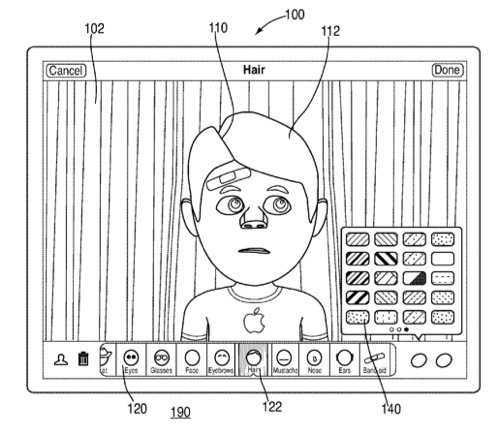Two new patents at the U.S. Patent & Trademark Office show that Apple is eyeing ways to enhance a 3D-like experience on its iOS and OS X devices.
Patents 20120079378 and 20120079377 are for systems, methods, and computer-readable media for integrating a three-dimensional asset with a three-dimensional model. Each asset can include a base surface and either a protrusion or a projection extending from the base.
Once the asset is placed at a particular position with respect to the model, one or more vertices defining a periphery of the base surface can be projected onto an external surface of the model. Then, one or more portions of the asset can be deformed to provide a smooth transition between the external surface of the asset and the external surface of the model.
In some cases, the asset can include a hole extending through the external surface of the model for defining a cavity. A secondary asset can be placed in the cavity such as, for example, an eyeball asset placed in an eye socket asset. Thomas Goossens is the inventor.
Here’s Apple’s background and summary of the invention: “Some electronic devices can display three-dimensional models that a user can control as part of an electronic device operation. For example, gaming consoles can display three-dimensional avatars that represent a user, and the user can direct the avatar to perform specific actions in a game. The three-dimensional models can be constructed from the combination of several assets such as a body, head, eyes, ears, nose, hair, glasses, hat, or other accessories.
“The assets can be placed adjacent to the external surface of the model. To enhance the user’s experience, the user can personalize a displayed model by selecting and moving specific assets with respect to the remainder of the model.
“An electronic device can display a three-dimensional model (e.g., an avatar) that may be constructed from several assets. For example, assets corresponding to facial features can be integrated into an external surface of a head asset or base structure of a model. Each asset can be incorporated in the model in a manner that may ensure that the asset is seamlessly integrated with an external surface of the model. When a user moves an asset with respect to the remainder of the model, for example, by dragging the asset, the asset can move in a manner that maintains a seamless integration of the asset with the external surface of the model.
“The asset can include a pivot point and a base surface. The pivot point can define a point of the asset that may have a consistent positional relationship with respect to any particular contact point along an external surface of a model with which the asset is to be integrated. The base can define a surface from which a protrusion or hole portion of the asset can extend. The periphery of the base surface can be defined as a sequence of vertices forming a closed path.
“When a user provides an instruction to place an asset on a model, a particular contact point on the external surface of the model that corresponds to the user-provided instruction may be identified, and the asset can be placed with respect to the model such that the asset’s pivot point coincides with the identified contact point. Then, one or more vertices of the base periphery can be projected onto the external surface of the model to ensure that the base periphery of the asset is entirely in contact with the external surface of the model.
“To ensure that the asset appears to be seamlessly integrated with the remainder of the model, a portion of the asset may be modified in the vicinity of the projected vertices. In particular, a region of an external surface of the asset can be re-defined such that the external surface of the asset may transition smoothly to the external surface of the remainder of the model adjacent the asset. When the asset includes a hole, a portion of the external surface of the model that is within an area of the asset’s base periphery may be removed such that an interior cavity of the hole can be exposed.”


